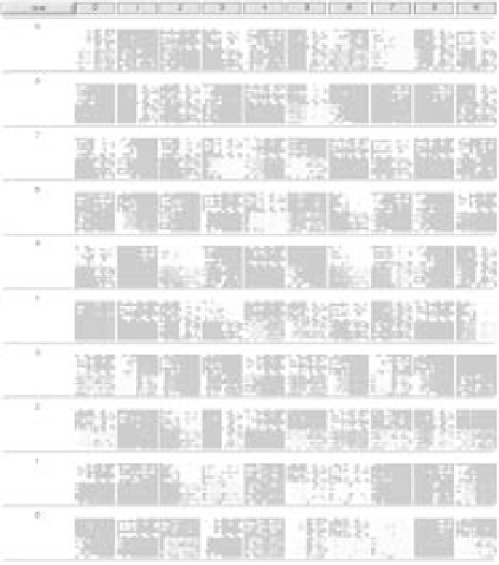Information Technology Reference
In-Depth Information
tions between subsequent V4 representations, and the
number of unique activation patterns.
Summary and Discussion of Receptive Field
Analyses
Using these techniques, we have obtained some insight
into the way this network performs spatially invariant
object recognition, gradually over multiple levels of
processing. Similarly, the complexity of the featural
representations increases with increasing levels in the
hierarchy. By doing both of these simultaneously and in
stages over multiple levels, the network is able to recog-
nize objects in an environment that depends critically on
the detailed spatial arrangement of the constituent fea-
tures, thereby apparently avoiding the binding problem
described previously.
You may be wondering why the V2 and V4 represen-
tations have their respective properties — why did the
network develop in this way? In terms of the degree
of spatial invariance, it should be clear that the patterns
of connectivity restrict the degree of invariance possible
in V2, whereas the V4 neurons receive from the entire
visual field (in this small-scale model), and so are in a
position to have fully invariant representations. Also,
the V4 representations can be more invariant, and more
complex because they build off of limited invariance
and featural complexity in the V2 layer. This ability
for subsequent layers to build off of the transformations
performed in earlier layers is a central general principle
of cognition (see chapter 7).
The representational properties you observed here
can have important functional implications. For exam-
ple, in the next section, we will see that the nature of
the V4 representations can play an important role in
enabling the network to generalize effectively. To the
extent that V4 representations encode complex object
features, and not objects themselves, these representa-
tions can be reused for novel objects. Because the net-
work can already form relatively invariant versions of
these V4 representations, their reuse for novel objects
will mean that the invariance transformation itself will
generalize to novel objects.
Figure 8.20:
V4 probe response fields. See figure 8.18 for
explanation.
ing activity patterns (table 8.2). One important statistic
is the number of different unique patterns (after binariz-
ing to 0-1 values based on a threshold of .5) that occur
on the V4 layers across all the 256 different positions of
a given object (recall that position is indexed by where
the lower left-hand corner of the object appeared) and
four different sizes. When we do this, there are on aver-
age around ten or so different V4 patterns, compared to
1024 different object images. Thus, we might conclude
that most of the time the V4 representation is fully in-
variant for a given object. Interestingly, this is true even
for the two novel objects that the network has never seen
before. This will prove critical for the generalization
test described below. A detailed report of the sweep
analysis can be found in the
objrec.swp_pre.err
file in
chapter_8
, which summarizes the results by
object (Item), size, object by size, and X, Y and XY
spatial coordinates, reporting errors, pairwise correla-

Search WWH ::

Custom Search